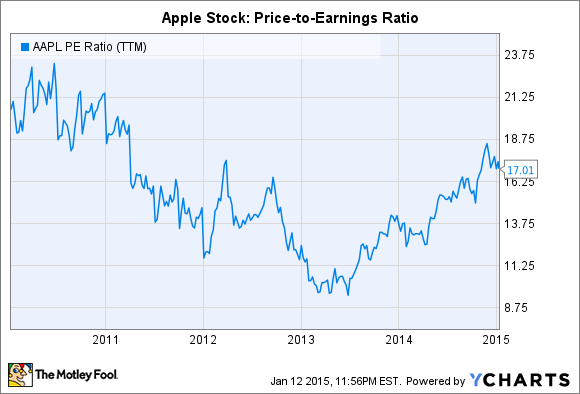Apple (AAPL 0.51%) stock has absolutely crushed the S&P 500's 10% gain in the past 12 months, rising almost 44%. With such a significant gain behind it and the New Year under way, it's a good time to take a look at the underlying value of Apple stock. Has the market got overly excited about Apple, or does the tech giant's underlying value support the higher stock price?
With two charts and a bit of perspective, we can get a clearer picture of Apple's value.
Price-to-earnings ratio
A price-to-earnings ratio, or P/E, is the most common metric the media uses to articulate and evaluate a stock's price in relation to a company's underlying value. It is simply equal to a stock price divided by earnings per share. In general, the lower the multiple, the lower the market's expectations are for a company's future earnings growth.
As a well-established company with fairly consistent levels of operating expenses as a percentage of revenue, the common metric is fairly useful for Apple investors.
AAPL P/E Ratio (TTM) data by YCharts
A glance at Apple's P/E today in relation to its volatility in the past five years highlights one obvious takeaway. Apple is no longer dirt cheap like it was in 2013 when it had a P/E ratio around 10. In fact, Apple's price-to-earnings ratio is at its highest levels since 2011.
Free cash flow yield
Apple is a cash cow. Nowhere is this more evident than on Apple's cash flow statement. Take Apple's operating cash flow and subtract capital expenditures, or cash used for investments in plants, property, and equipment and for acquisitions, and investors can get an idea of just how monstrous Apple's free cash flow is.
In fiscal 2014, Apple brought in $49.9 billion in free cash flow. While that's enormous in absolute terms, it's also impressive when viewed as a percentage of Apple's stock price. Divide Apple's free cash flow by the stock's current market capitalization and you'll get 7.5% -- a figure that is slightly favorable to Microsoft stock's 6.9% yield and well ahead of Intel's 5.2% yield.
AAPL Free Cash Flow Yield (TTM) data by YCharts
Again, just as was the case for Apple's price-to-earnings trend, one of the key takeaways here is the difference between the metric in 2013 and the metric today. While Apple still has a reasonable free cash flow yield, the stock definitely isn't the bargain it was last year.
Growth expectations
Valuation without some consideration of future potential growth in the stock's intrinsic value is of little value. So, what kind of earnings growth can we expect from Apple going forward?
To get an idea of where Apple's business could go in the coming years, look no further than the tech giant's iPhone segment. At 56% of revenue, the segment is Apple's largest and most important.
Fortunately, the segment is performing exceptionally well. In Apple's most recent quarter, iPhone revenue was up 21% from the year-ago quarter. For Apple's fiscal Q1, which Apple will report results for later this month, analysts are expecting record iPhone sales of around 63 million, up 23.5% from Apple's year-ago record-breaking quarter of 51 million units.

iPhone 6. Image source: Apple
Looking out further, the continued two-year average upgrade cycle for smartphones combined with growth prospects in China and other developing countries should provide more upside potential for Apple's largest business.
Beyond the iPhone, Apple's upcoming Apple Watch could also bring upside to earnings while also help make the value proposition for existing customers to stay in the Apple ecosystem of products and services even more compelling.
With these sort of growth prospects, a conservative estimate for Apple's EPS growth in the next five years is probably about 10% to 15% -- which is more or less what investors would expect from a company trading at 17 times earnings.
Pairing these two charts with expectations for moderate earnings growth, Apple stock looks worth holding on to. But whether or not it is still a buy is now a much tougher question than it was in 2013.







